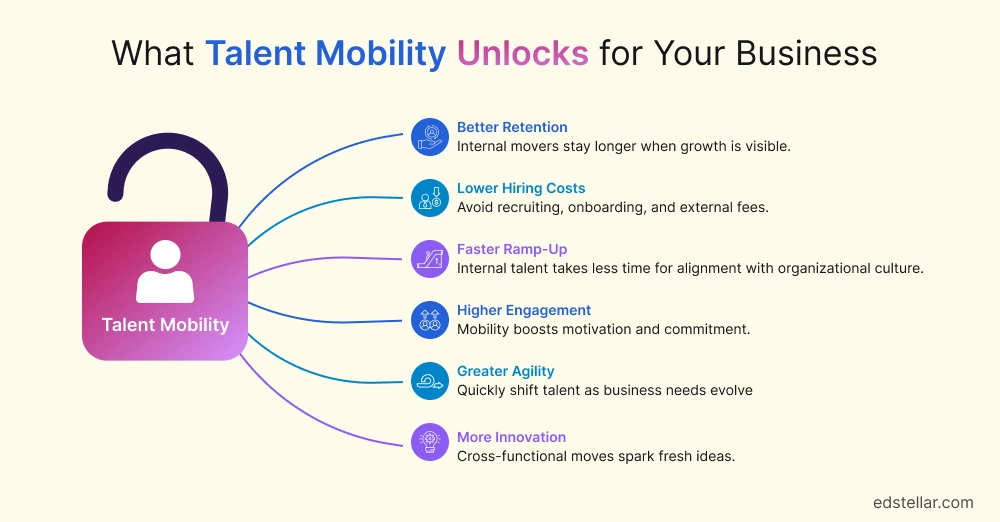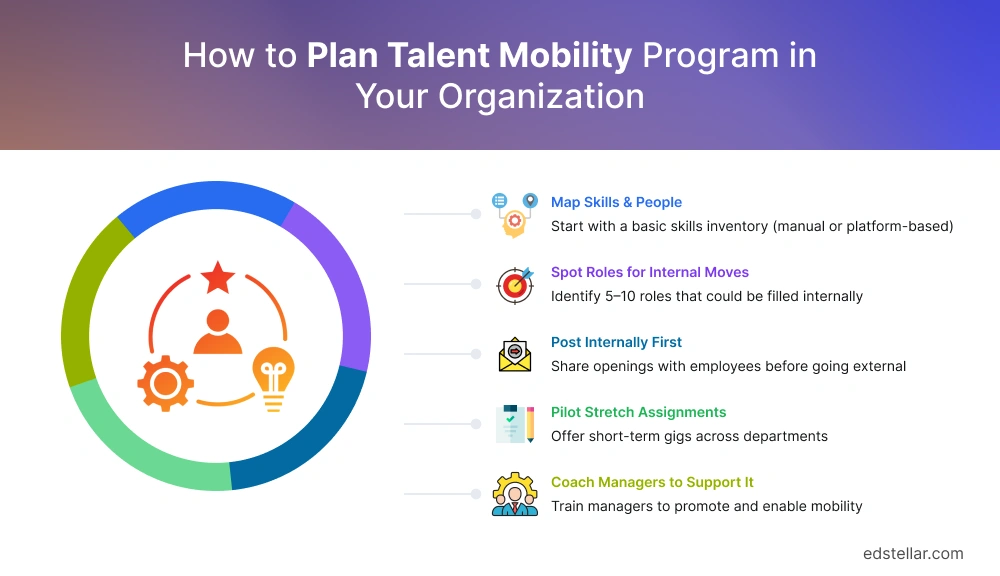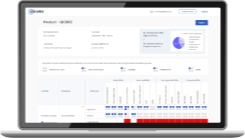
Skills are becoming obsolete faster than ever, with the World Economic Forum’s Future of Jobs Report (2023) indicating that 44% of workers’ core skills will change within five years due to technological advancements like AI and automation. The half-life of a skill is now approximately 2.5 years, reflecting the rapid pace of disruption in fields requiring cognitive and technological literacy.
This accelerated obsolescence underscores the need for continuous learning, as employees are no longer loyal to companies that block growth. According to LinkedIn Learning, 94% of employees say they’d stay longer if their company invested in their career development.
These trends signal that organizations must prioritize skill development and adaptability to retain talent in a competitive, skills-driven market.
Organizations must rethink their structures to allow internal movement, as traditional hierarchies and static roles are holding back both employees and organizational agility. Talent mobility is about removing those barriers, allowing employees to evolve, explore, and stretch into new roles internally, without leaving the company.
Companies fostering learning cultures see higher retention and stronger management pipelines. However, implementing fluid systems remains challenging, particularly in large organizations with entrenched processes or smaller firms with limited role flexibility.
Despite these hurdles, the focus on internal mobility aligns with the projected need for 59% of the global workforce to be trained by 2030, with 29% upskilled.
This guide explores why talent mobility, which is moving people across roles and projects inside your organization, is rapidly becoming a competitive necessity for CHROs and business leaders.
The Urgent Case for Talent Mobility in Today’s Workforce
High turnover remains a persistent issue. According to Mercer, U.S. voluntary turnover averaged 13.5% in 2023; that’s nearly 1 in 7 employees. Yet, many are leaving not for better pay, but due to a lack of career development. Gallagher reports that career growth opportunities now significantly influence retention and engagement. Companies investing in internal mobility see tangible gains: employees who move internally are 40% more likely to stay three years, and overall tenures increase by 53%.
Traditional hiring is also costly and slow. Recruiters LineUp notes that external hires cost 1.5–2× more than internal promotions. The average cost per external hire is $4,700, and can exceed $28,000 for executive roles. Meanwhile, promoting internal talent is faster and cheaper, with 70% of promoted employees staying, double the rate of those not promoted.
Despite this, companies often overlook in-house talent. Many face talent shortages while denying qualified internal candidates, wasting both time and money. At Schneider Electric, launching a talent marketplace unlocked 127,000+ hours of work, equating to millions in savings.
In sum, looking outside first leaves money on the table. A side-by-side cost comparison reveals why internal mobility is more efficient:
Bottom line: lack of career development is a top push factor, and failing to tap internal talent is a critical missed opportunity.
What is Talent Mobility
Talent mobility refers to the strategic movement of employees across roles, not just upward promotions, but lateral moves, stretch assignments, global rotations, and gig-style projects. It reimagines talent as a renewable resource, aligning people with shifting business needs based on evolving skill profiles.
In contrast to the traditional “career ladder” mindset, this approach fosters agility and transparency. According to research, 73% of employees want visibility into internal opportunities, and over half say it would increase their retention and satisfaction.
Josh Bersin describes talent mobility as key to organizational adaptability:
“It goes far beyond succession; it represents your company’s ability to move people as business needs change.”
Bersin's team found that high-performing companies like GE and IBM excel by embedding transparent mobility systems, including internal marketplaces, career portals, and rotational programs. Yet, many firms still lack structured processes, resulting in missed opportunities and talent loss.
In short, talent mobility is a foundation for modern talent management and long-term competitiveness.
Why Talent Mobility Matters
Unlocking Internal Potential and Reducing Hiring Costs
- Tap Hidden Skills: Many employees already have underutilized abilities. A Deloitte survey found that 71% of workers perform tasks outside their formal job description. Skills-driven (mobility-friendly) companies are 107% more likely to place the right people in new roles, showing that redeploying existing talent fills gaps quickly without costly outside hires.
- Cut Recruiting Expenses: 79% of L&D leaders say it’s cheaper to train a current employee than recruit anew. By contrast, external hires cost around $4,129 on average and take ~42 days to fill. Internal moves save on advertising, interviewing, relocation, and onboarding costs.
- Faster Productivity: Internal hires ramp up quicker. A study from Cornell shows internal candidates often outperform external hires because they know the company’s culture and processes. They also stay longer as high-performing internal recruits tend to remain on the job, whereas external hires often churn faster.
- Leverage Existing Investment: Shifting talent internally maximizes past training spend and avoids “knowledge loss.” By filling roles with in-house employees, companies keep institutional know-how engaged and avoid the downtime typical of external vacancies.

Boosting Retention and Engagement through Career Growth
- Higher Retention: Employees who move internally are far more likely to stay. LinkedIn data shows staff who switch roles within the company have a 64% chance of remaining after three years, versus only 45% for those who don’t move. Indeed, workers stay about 60% longer at companies with strong internal mobility programs.
- Valuing Promotions: Career advancement pays off. Workers promoted within their first 3 years on the job are roughly 60% more likely to remain with the company. Ultimately, visible growth paths anchor talent.
- Boosted Engagement: Mobility drives enthusiasm. Employees who change jobs internally are ~3.5× more likely to be highly engaged than those who stay in the same role. Highly engaged teams are more productive (e.g., Gallup links engagement to ~21% higher output) and have lower absenteeism and turnover.
- Meet Expectations: Today's workforce expects opportunity. About 73% of employees actively seek information on internal openings, and 61% say they would quit if they see no clear advancement path. Offering career mobility signals to staff that the company cares about their growth, which in turn increases loyalty and reduces voluntary turnover.
Business Agility and Organizational Resilience
- Quick Role Changes: In a crisis, mobility pays dividends. For example, when COVID lockdowns forced Verizon to close ~70% of its retail stores, it used a skills platform to redeploy 20,000 employees into other critical roles instead of laying them off. This kept operations running and customers served with minimal disruption.
- Adapt to Change: Organizations with mobility-driven, skills-focused models are far more agile. Deloitte found that such companies are 57% more likely to anticipate market changes and adapt effectively. In practice, a mobile workforce means management can pivot resources swiftly (e.g., shifting people into high-demand teams or new projects) without lengthy hiring delays.
- Bridge Akill Gaps: Moving people internally is the fastest way to plug pressing skill shortages. Project-based swaps and rotations dispatch employees with transferable skills to where they’re needed, often on the same day. Consistent with this, Deloitte reports that skills-first firms are 52% more likely to innovate and 107% more likely to place talent effectively. These agility gains help organizations withstand shocks and stay competitive.
- Drive Innovation: Internal moves break down silos and bring fresh perspectives. Diverse teams assembled from different departments generate more creative solutions. Indeed, companies prioritizing internal mobility (often along with diversity efforts) tend to outperform peers. Deloitte notes they are 52% more likely to innovate. Besides, 98% more likely to retain top performers. This resilience and innovativeness make the business stronger overall.
How to Implement a Talent Mobility Program

Step 1: Start with a Talent Visiblity Exercise
- Map the Organization: Pull together up-to-date org charts, team rosters, and role descriptions. This gives a clear picture of who’s in what role across the company.
- Nominate Talent: Ask managers to flag high-potential employees or anyone ready for a new challenge. These nominations identify staff who could move.
- Inventory Skills: Use a simple spreadsheet to log each person’s key skills, certifications, and interests. For example, list that Jane’s list includes “Java, project management, speaks Spanish.”
- Capture Hidden Skills: Encourage employees to self-report side-projects, language skills, or past roles not on their resume. (Subtle abilities like UX design from a hobby can be gold.)
- Why it Works: This DIY skills audit is a low-cost shortcut to a formal talent marketplace. It creates the starting database for internal matching, even before any fancy software is in place.
Step 2: Identify Roles That Can Be Filled Internally
- Analyze Vacancies: Look at current openings with unusually long time-to-fill or high turnover. These often signal roles that are hard to recruit externally.
- Flag suitable Positions: Identify jobs that don’t completely require outside expertise. For example, a mid-level analyst position could be covered by an internal candidate who gets some quick upskilling.
- Set Priorities: Make a shortlist of ~5–10 roles where internal moves seem most feasible. Focusing on a small set of critical roles (rather than trying to convert every opening) generates early wins and builds confidence.
- Focus Effort: This targeted approach means HR and managers can collaborate on realistic moves. It avoids “boiling the ocean” and helps prove the value of mobility in manageable steps.
Step 3: Open Internal Applications Before Going External
- Internal Posting Window: Institute a policy that every new job is advertised internally for, say, 10–14 days before you seek external candidates. This ensures current employees get first crack.
- Company-Wide Promotion: Use email, your intranet, or even a shared spreadsheet/dashboard to broadcast each opening across teams. Announce new roles in all-hands or newsletters so nobody misses them.
- No Red Tape: Make internal applications easy. Skip lengthy forms and let interested employees simply express interest or send a note. Avoid requiring an outside referral or jumping through HR hoops.
- Build a Culture: This “mobility-first” hiring practice creates momentum. Over time, employees learn that any time a position opens, they have a fair chance to apply. It signals that career growth is encouraged.
Step 4: Pilot Lateral Moves and Temporary Assignments
- Offer Short-Term Gigs: Create opportunities for brief internal moves – for example, a 3-month stint on a cross-functional project, maternity-cover assignments, or a temporary project taskforce.
- Gather Feedback: After each assignment, check in with the employee and the host manager. Did the employee learn new skills? Did the team benefit? Use simple surveys or just quick chats.
- Build Comfort: These low-risk pilots help everyone see mobility in action. Managers experience the benefits of flexible resourcing, and employees gain confidence in trying new roles.
- Win-Win Boosts: Early “stretch” assignments often work well. The employee feels challenged and appreciated, and the company taps extra capacity without delay. These successes make future moves less intimidating.
Step 5: Coach Managers to Support Internal Movement
- Raise Awareness: Run short workshops or share case studies showing the ROI of mobility. Emphasize that sharing talent (not hoarding it) is good for their team and the company.
- Career Conversations: Train managers on how to discuss career aspirations during performance reviews. Encourage them to ask “Where do you want to grow?” and guide employees to relevant opportunities.
- Recognize Talent-Sharing: Create incentives. For example, celebrate or reward managers when someone on their team gets promoted or takes a new role internally. Show that developing people is valued.
- Leadership buy-In: Manager resistance is a common barrier (Deloitte notes ~46% of firms cite managers’ reluctance to lose staff as a blocker). Overcoming this requires senior leaders to champion mobility. When execs publicly praise internal moves, managers follow suit.
Leveraging Skills Intelligence Platforms
- Automate Skills Mapping: Modern platforms can scan resumes, training records, and past project data to automatically profile each employee’s skills. This builds a live, searchable skills database for the whole organization.
- Uncover Hidden Matches: These systems go beyond exact titles. In one experiment, including related skills in the search expanded the candidate pool dramatically, yielding 89% more skill matches and ultimately 179% more potential candidates for an opening. In practice, this means spotting internal fits you’d otherwise miss.
- Case Study: Verizon, a major US telecom, used a skills platform when COVID hit. By analyzing 20,000 employees’ skill sets, the company redeployed staff into new roles (e.g., from stores to network support) rather than laying them off. Tools like this made it possible to do in days what might otherwise have taken weeks or months.
- Speed up Placements: With up-to-date skill data, managers can “quickly identify the right talent” for a project or opening. Booz Allen found that after deploying a skills intelligence system, bench time (idle staff) fell, and the rate of internal hiring rose. In other words, fewer people are waiting around unassigned, and more roles get filled from within.
- Instant Visibility: Ultimately, a dedicated skills intelligence solution keeps your talent inventory fresh. Instead of manual spreadsheets, you get real-time dashboards of who can do what. This turbocharges every step from visibility to matching candidates and making the mobility program far more efficient and data-driven.
Talent Mobility Implementation Roadmap: Key Takeaways
Throughout each phase, use change management best practices: involve executives, highlight quick wins, and keep communication channels open. Train not just HR, but also line managers, to overcome objections early by showing how mobility strengthens teams rather than weakens them. Evaluate success with clear KPIs and adjust the course as needed.
Conclusion
Talent mobility is the future of workforce strategy, empowering employees, reducing turnover, and driving business agility. Organizations that fail to adopt flexible talent models risk losing top performers to competitors who offer clearer growth paths.
By mapping skills, prioritizing internal hiring, and fostering cross-functional movement, companies can build resilient workforces ready for rapid change.
Edstellar, a leading corporate training and coaching provider, helps businesses build a mobility-first culture with:
✔ 2,000+ instructor-led programs (IT, Leadership, Compliance & more)
✔ Skill Management Software and Skill Matrix to track and deploy internal talent
✔ Customized training to bridge skill gaps and accelerate internal mobility
Transform your workforce strategy; explore Edstellar’s solutions and schedule a demo today.
Explore High-impact instructor-led training for your teams.
#On-site #Virtual #GroupTraining #Customized

Bridge the Gap Between Learning & Performance
Turn Your Training Programs Into Revenue Drivers.
Schedule a ConsultationEdstellar Training Catalog
Explore 2000+ industry ready instructor-led training programs.

Coaching that Unlocks Potential
Create dynamic leaders and cohesive teams. Learn more now!


Want to evaluate your team’s skill gaps?
Do a quick Skill gap analysis with Edstellar’s Free Skill Matrix tool

Transform Your L&D Strategy Today
Unlock premium resources, tools, and frameworks designed for HR and learning professionals. Our L&D Hub gives you everything needed to elevate your organization's training approach.
Access L&D Hub Resources.svg)
.svg)



.svg)


.svg)
.svg)
.svg)
.svg)

